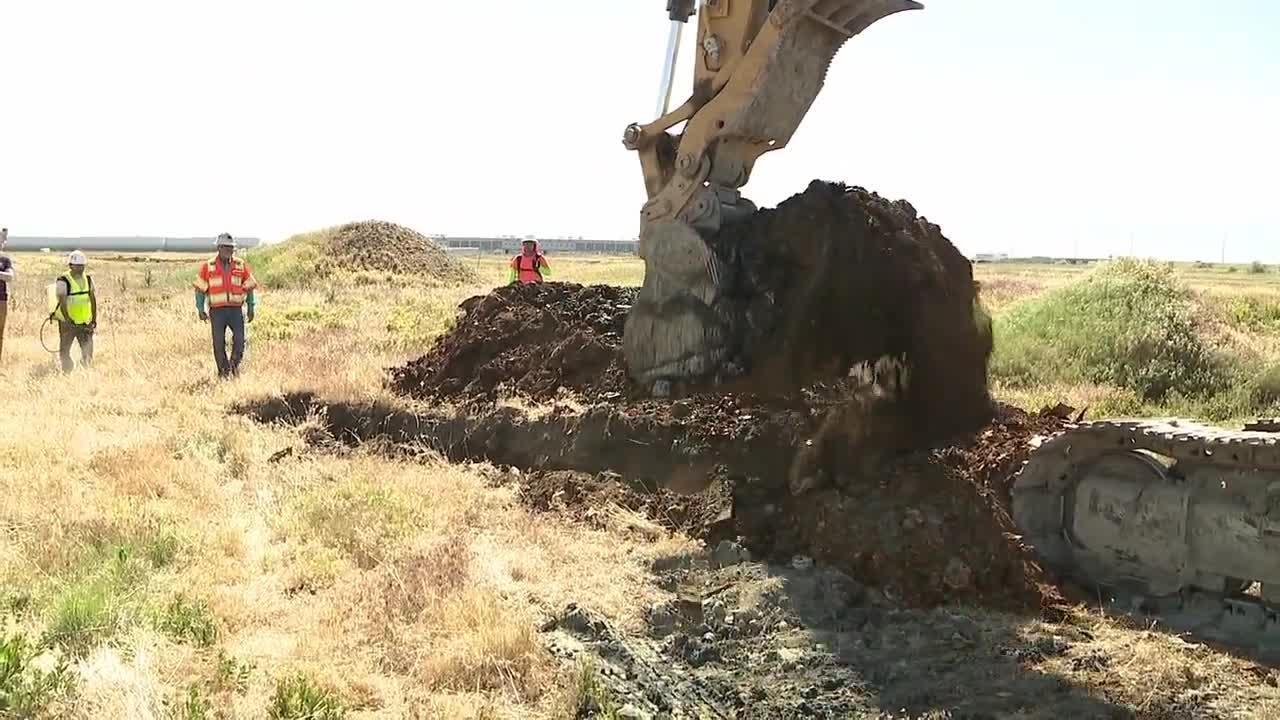SALT LAKE CITY — The backhoe started digging in the empty field, unearthing trash from decades ago.
This site near I-80 and 7200 West is the old Salt Lake Valley landfill. It will become a new site for the Utah Inland Port, which has been billed as one of the largest economic development projects in state history. It bypasses a traditional coastal port and gets goods in and out of the region using road, rail and air. The project, supported by massive distribution warehouses, is expected to generate thousands of jobs and pump hundreds of millions of dollars in Utah's economy.
"All of these warehouses have hundreds and hundreds of thousands of trucks that come in and out of here every day. So we know this is an infrastructure mecca. Bringing rail out of this site is really important," said Abby Osborne, the board chair of the Utah Inland Port Authority, motioning to the nearby warehouses.
Sale of Utah public lands yanked from Trump's 'Big, Beautiful Bill':
On Wednesday, crews started working on the $200 million project. It will take about seven years to remediate the old landfill and it will be delicate work. There's potentially hazardous chemicals and asbestos.
"Some of the waste hasn’t decomposed and as it decomposes, it gives off gases. You don’t want those gases to migrate into a building and be a health hazard," said Gary McEntee with Ninigret Management, which is working on the landfill remediation.
Newer technologies will be utilized to help protect the Great Salt Lake, which is nearby. As the landfill is dredged up, waste will be processed and the leachete will be pumped into nearby ponds to be processed. It will only get more tricky as the project moves on, McEntee said.
"As you go to the west, the waste gets a little bit deeper, gets a little bit more complicated. As you saw when we did the excavation when we pull up decomposed waste, bottles, stuff like that. No plastic," he told FOX 13 News. "When you get to 1970? The amount of plastic is ridiculous and plastic doesn’t decompose."
To say the inland port project is controversial is an understatement. When it was first envisioned in 2018, it sparked heated protests and lawsuits. The Utah Inland Port Authority pivoted away from a single site in Salt Lake City to smaller hubs around the state where they have largely been welcomed by rural communities seeking economic development.
While the demonstrations against it are more subdued these days, one lawsuit challenging the port authority's creation and some of its projects is going forward. In remarks at an event on Wednesday, Sen. Jerry Stevenson, R-Layton, who passed the bills that allowed the Utah Inland Port to happen, actually offered some praise for critics of the project.
"There’s been some folks that haven’t been totally loving this process that we’ve gone through," he told a crowd gathered at the old landfill site. "But I will tell you that they’ve helped us make the changes that we’ve needed to get to where we are today."
Deeda Seed with the Stop the Polluting Port Coalition said she's glad to hear that political leaders acknowledge harms, but she said she wanted to see more action.
"Remediating the landfill itself is not a bad thing. But the whole intent of this is to incentivize and fast-track industrial development. That’s where we have a problem. Even as we’re standing here today? The air quality is not great," she told FOX 13 News.
Seed is a plaintiff in the most recent lawsuit over the inland port. She would not rule out future litigation. Among environmental groups' concerns is protecting the Great Salt Lake, which has already been the subject of a lot of public alarm as it continues to shrink. The Utah Inland Port Authority insists that their efforts are helping the lake, as they are blocking more destructive development and ensuring sensitive wetlands are protected.
"I would say if we just sat back and did nothing, as the state, if we continued to do nothing? That’s when it harms the Great Salt Lake," Osborne said, referencing the landfill site. "You saw the leachate, and you know it’s migrating toward the lake. We know the plume is going that way. The best way for us to protect the lake, protect the wetlands, is close it off."
Salt Lake City Council member Victoria Petro, who represents many west side communities impacted by the port and serves on its board, said her constituents have mixed feelings about the port project.
"My district is a mix of people who are concerned both about the air they can breathe but also their economic mobility as traditional blue collar workers," she told FOX 13 News. "So it’s always been a mixed bag for us. I think the leadership that we have now is really making a concerted effort to understand that they need to protect us both economically and environmentally, and that has been a positive thing."
In addition to economic opportunities, the Utah Inland Port Authority has insisted it will invest in more environmentally-friendly technologies including electric vehicles to help with its operations.
"We have a lot of work to do. Many, many years of cleanup," Osborne told FOX 13 News. "We’re going to be aggressive. We’re going to do it right. We’re going to protect the businesses that are here. We’re certainly going to protect the lake. We’re going to build a world class, infrastructure and advance manufacturing facility here. It’s going to be amazing when it’s all said and done."
This article is published through the Great Salt Lake Collaborative, a solutions journalism initiative that partners news, education and media organizations to help inform people about the plight of the Great Salt Lake—and what can be done to make a difference before it is too late. Read all of our stories at greatsaltlakenews.org.




